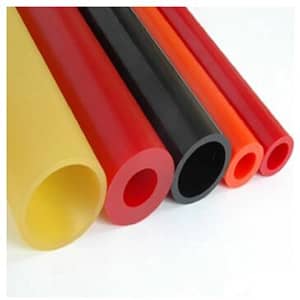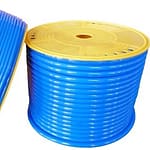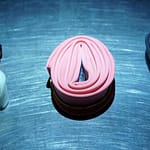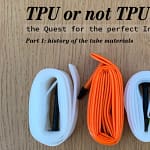Types of Inner Tubes
inner tubes or tpu tubing don’t cost a huge amount of money but along with tyres they’re one of the biggest bank fees for upgrades that you can make not just in regards to the weight but
also and more importantly about the rolling resistance too cyclists have long known about the importance of rolling resistance especially.
when selecting tires for time trials races but even just general riding as far back as the 70s and 80s riders were picking special indoor-specific velodrome tyres to use in outdoor time trials because they knew they were thinner and faster a high rolling resistance meant that they would have to put out more power to travel the same speed whereas a lower rolling resistance.
means you could put out less power to travel that same speed so in this video we’re going to look at the relative pros and cons of all the different inner tube types out there and explain the differences between them let’s begin with the different types of tube and how much they typically cost starting with butyl tubes these come in a variety of different thicknesses.
you’ve got big chunky ones for gravel and mountain bikes and you’ve got thinner ones as well which are suited towards road bikes and they also come in different thicknesses because you can get some super lightweight ones for example Pirelli makes its standard kind of sport tube and then a lighter thinner one that they call the road tube other brands make even thinner and lighter ones than that but more on that in a sec,
typically butyl tubes cost around two to five pounds euros or dollars depending on the exact
type you’re buying and how many you’re buying if you’re buying bulk it can be a bit cheaper
next up latex tubes Ollie’s favorite as the name suggests are made from latex rubber and are available by several different brands they’re usually pink or sometimes green but,
Butyl Tubes:
they’re not black like butyl tubes and they’re a bit more expensive butyl tubes typically cost around 10 to 12 pounds euros or dollars again this depends on how many you buy because you could be cheaper to buy them in bulk and then we’ve got the relatively new kids
on the block tpu inner tubes which is a thermoplastic and it’s made from polyurethane yes and again a number of brands make these but this is Pirelli’s version it’s called a smart tube and incredibly light.
the lightest of the three options but also usually the most expensive they typically cost around 17 to 25 pounds euros a dollar depending on where you get it from the exact tube you get there is of course always the fourth option as well and that is to not use any of the above options and go for a tubeless tire setup you love tubeless yeah did I mention i love tubeless tires um but anyway we won’t cover that here we’ve covered that in lots of other
Blog.
it’s a completely separate different topic but we do have videos on it having established the different types of inner tubes we’re now going to talk about rolling resistance because if you’re trying to be as fast as possible and performance is your reason for being then your
number one consideration when selecting inner tubes.
should be rolling resistance it’s the interaction between the inner tube that you’ve got fitted inside your tire and the tyre itself which dictates your rolling resistance you can in fact feel
the difference between a slow setup and a fast set up one of the most comprehensive studies into inner tube rolling resistance was conducted by a good friend’s error coach this is an independent study where they quite simply aim to find the lowest rolling resistance inner
tubes the take-home message from the results resistance is butyl these tests show
that the redder sign later seriously is they showed that the Vredestein latex in the tube was the fastest so this had the lowest rolling resistance and then was closely followed by the
Vitoria latex in the tube and then the challenge in the tube as well again a latex one
and these saved on average seven watts for a pair of wheels compared to a standard butyl
the tube which is not a good saving isn’t it yes now especially considering the cost of seven watts equates to roughly 12 seconds saved in a 16-kilometer or 10-mile time trial according to
aero coach but it might not sound like much to you but it could be the difference between winning or losing and also if you extrapolate that over the course of a longer ride.
tpu Tubing:
it could be a lot of time indeed studies have also been carried out independently by bicycle rollingresistance.com and they’ve come up with similar results to aero codes which is encouraging as for the tpu inner tubes well both the studies tend to suggest that these fall somewhere in between the latex tube and the butyl tube for rolling resistance so typically a couple of watts faster than butyl and a couple of,
what’s slower than latex but what about the weight because the weight is another consideration that we need to take into account many of us like this are obsessed over the weights of the components of our bikes yeah and the lightest inner tubes by far.
it’s a win for the tpu i mean these things are ridiculous there’s even a picture of a feather on the box but when you weigh it you know like 35 grams outrageous when you compare that to a standard butyl tube i mean 138 grams so massive what saving and although you
know when it comes to you know these being considerably more expensive than these in a kind of like cost per gram saving you’re doing the the difference in weight here is like
a thousand pounds if you’re talking in wheels or bike frames yeah it is it’s very true a similar size latex energy weighs in around 75 grams and sits somewhere in the middle between the tpu and the button in a tube so such as that pink one there that ollie’s
got now if you go for a more performance butyl tube or the weight comes down like we
mentioned so around sort of 80 grams is considered comparable to the latex tube and then if,
you go for a super light super thin butyl tube they’re usually around 50 grams so lighter still but still not quite as light as the tpu but how much difference does this weight actually make i’m glad you asked that Alex so if you saved around 160 grams across your two inner tubes by switching to lighter ones when traveling up a 16 gradient that would equate to around
point eight of a watt saved.
um well it’s still a gain um or naught point naught three kilometers an hour so not much at all
and it’s important to point out that the res the what’s saved from rolling resistance counts for more than what you’re saving from weight in this situation so if you remember even with the tpu tube 2 watts slower in terms of rolling resistance versus 0.8 of a watt saved in weight but
you’re not even saving that much because the latex tube is not much heavier rolling
resistance trumps weight next up braking now if you’re using disc brakes you can use whatever type of inner tubes you like however if you’re using rim brakes you do need to be a bit mindful because on prolonged braking on long descents, you will build up some heat inside the rims and you do need to be mindful of what inner tubes you’re using because,
some of them are not recommended for rim brakes yes some inner tubes can fail when prolonged due to the heat build-up up and i would yes as Alex says look at what the manufacturer
recommends for example,
continental recommends that its super thin light butyl supersonic inner tubes are not used in hilly terrain next we’re going to discuss practicality beginning with air retention and there
is a clear winner here and it is butyl so if you want anything for an easy life and you don’t want to have to pump up your tires every single day and you want them to hold air butyl tubes they’re the way to go the other two tube types leak air at increasing rates so next comes tpu and then lagging is latex if you use latex tubes and you want to have the right tyre pressure you’re gonna have to pump them up pretty much every single day there’s
other implications for this such as if you’re riding a back-to-back multi-day event maybe something like a transcontinental and you don’t necessarily want to bump up your tires.
every day latex might be something to reconsider or if you’re racking your bike ahead of
a race the next day often is the case in triathlons then yes again factor in that your tyre pressure is going to be less when you start your event than when you wrapped your bike
the day before and if you want an inner tube that’s faster than a standard butyl energy but
you don’t want to have to pump your tires up every single time then the tpu or thermoplastic inner tube is the way to go these do still have a leak a little bit of air slowly over time because they are still porous but it’s a much slower rate than what a latex one does yeah as shown by
a cool study done by bicycle rollingresistance.com and remember the tpu in a tube has the added benefit of being that little bit lighter because it’s not just the weight of the inner tubes inside your tires it’s also the weight of the inner tube that you’re carrying around in your spare so in your saddlebag or your pocket for example as for punctures well it depends on who you ask some people will say these inner tubes puncture more and some people will say these inner tubes
puncture more but we’ve not seen any quantitative scientific data that suggests that any particular inner tube punctures more than another that said you would expect that a slightly
thicker butyl heavy-duty tube is going to offer a tiny bit more protection than a super light kind of supersonic 50-gram one but in our experience again the thing that makes the biggest difference to punctures is the tire carcass and the tire you’re using rather than the inner tube that’s in it,
and if you do suffer a puncture butyl inner tubes are easily repairable with uh you know standard patches they’re easily available and you can also use those same patches on latex in the tubes,
however, if you are patching a latex inner tube something i have some people do is use
an old latex tube to cut up and form their own patch and then stick that on the latex tube tpu inner tubes however are also repairable this is something that you didn’t know until i didn’t know about this um so there are a couple of brands out there that make repair kits for this type of energy band well they’re just repaired in a very similar process to what you would do
with a standard inner tube that said if you’ve had a blowout and your inner tube is torn and ripped to shreds as can sometimes happen unfortunately.
then they’re not repairable with no installation but our tubes are clear winners again they’re the easiest tubes to install into your tires tpu they’re pretty easy too but latex are noticeably a bit more of a faff i mean latex tubes they is more delicate meaning it can be easy to break them when you install them what often happens is people bang them in their tires and then they pump them up to 100 psi they’re all excited because they just got latex tubes and a little bit of the tubes got caught under the bead of the tyre causing it to go bang as soon as they’ve
they’ve pumped it up which is quite scary also if you’re installing them don’t use tire levers as this can very easily because they’re delicate just nick the tube and put a tiny hole in it and
Then a neat little tip that many people can do is just to inflate the inner tube very slightly so that it holds its shape and that way as you’re putting it into the tire you reduce the risk of pinching it when you’re fitting the tire on or using your tire
lever as well and before you do go to fully inflate a latex tube always check that it’s no part of it around the rim is caught under the bead of the tire in any way latex tubes are not just more
physically delicate they’re more chemically delicate too so be careful not to let them get
into contact with solvents and chemicals as that can easily damage them something else you should also be mindful of particularly if you’re at the roadside pumping your tyres up
is when using a co2 cartridge for example now this isn’t a problem I’ve had myself but i have heard in the
past when using a co2 cartridge it makes the latex energy you go quite brittle and then you run the risk of it failing yeah so a simple solution would be that in your spare bag that you carry with you on your rides put in either a tp youtube or a butyl tube rather than a latex tube
now we’ve covered a lot so far but what about ride quality is particularly hard to disseminate and i have heard some writers saying they prefer the ride feel of a latex in
a tube because it’s far more supple when it conforms and deforms the road surface far more
but i can’t say this is something that I’ve been able to tell in the past but something that i do think has far greater importance is the tyre pressure and the tyre width however what is
definitely perceptible is the feeling of speed you get if you switch from a slow-rolling winter tire to and big thick butyl tube.
to a really fast racing tire and a latex tube i mean it’s night and day the difference can
easily be something in the region of 25 watts and that i means if you ride it back to back trust us you’re welcome to try it you will you’ll be able to feel the difference in summary if you’re racing or doing time trailing then latex inner tubes
Conclusion
could be the way to go but if you’re just doing general-purpose riding or riding off-road perhaps then the butyl inner tube could be the one for you it’s also the lowest cost option and doesn’t need regular inflation or anything for an easy life but if you’re going to be racing
uphill or riding on back-to-back days where you don’t want to have to be inflating your tyres or just a mad weight weenie than tpu tubes this is the way hopefully you enjoyed hearing our thoughts on all the different types of inner tubes that are available and why not let us know
your thoughts on them in the comments section down below and remember resistance is butyl
bye see ya





